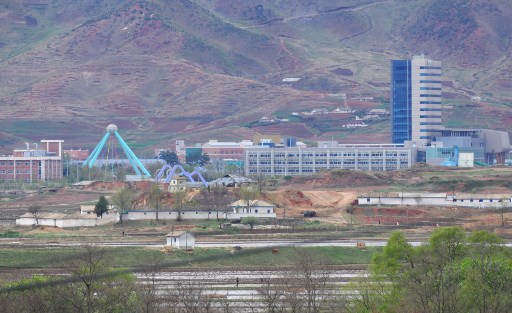

North Korean leader Kim Jong Un and the South’s President Moon Jae-in have followed paths to power as radically different as their two countries, but they will come together at a summit in the Demilitarized Zone on April 27. / AFP PHOTO / Jung Yeon-je
by Sunghee Hwang
Agence France Presse
GOSEONG, South Korea (AFP) — When Kim Jong Un steps over the Military Demarcation Line to attend a summit on Friday he will be the first member of Pyongyang’s ruling dynasty to set foot in the South since the Korean War.
But his grandfather Kim Il Sung used to have a holiday home there.
Nestled on a cliff overlooking the white sands of Hwajinpo Beach in Goseong, just a few kilometers from the eastern end of the Demilitarized Zone that divides the peninsula, stands a small stone villa surrounded by tall pine trees.
Now known as Hwajinpo Castle, the North’s founder and his family vacationed there until the outbreak of the Korean War, when it was part of his territory.
Outside, a reprint of a faded black-and-white photo shows five children perched on the steps rising towards the entrance — among them Kim Jong Un’s father and predecessor Kim Jong Il, aged six.
A metal plaque marked with an arrow reads: “The spot where Kim Jong Il and his sister Kim Kyong Hui were photographed in August 1948.”
Goseong county, along with a swathe of what is now the South’s Gangwon province, fell into the northern zone when the US and Soviet Union agreed to divide the peninsula at the 38th parallel after Japan’s surrender ended the Second World War and its colonial rule over Korea.
One of the few areas to change hands after the brutal 1950-53 conflict — during which millions of people died and control of Seoul changed four times — it is now part of the South’s Gangwon province.
There are a few other similar legacies — a three-story building in Cheorwon, north of Seoul, is now an empty shell, but was once a regional headquarters for the North’s ruling Workers’ Party of Korea.
“For five years, North Korea ruled this area committing numerous brutal acts such as torturing and killing people,” reads a sign outside.
The Hwajinpo villa was significantly damaged in the war but was restored and used as a resort for South Korean soldiers, before opening to the public as a museum in 1999.
“This building is where they stayed,” said tour guide Ham Ji-su.
The rooftop offers a magnificent ocean view and inside a humble room showcases items — a single bed, closet, radio and telephone — dating from the era when the house was used by the Kim family.
‘Hail of shells’
Kim Jong Il never went back to the South, although he met two South Korean presidents at summits in Pyongyang, Kim Dae-jung in 2000 and Roh Moo-hyun in 2007.
But according to official North Korean biographies, Kim Il Sung went to Seoul and beyond in the early days of the Korean War, as his forces pressed southward.
In the “dead of night” Kim crossed a bridge over the Imjin river by car, “braving a hail of shells, and went to the Front Command in Seoul”, says the “History of Revolutionary Activities of President Kim Il Sung”.
After the capture of Daejeon, it says, “Kim Il Sung went to the front in person, and commanded the offensive operations of the KPA (Korean People’s Army) units on their southward advance”.
On another more quotidian occasion “he went to Seoul in person to look after the living of citizens ranging from the supply of food and firewood to vegetables for kimchi”, it adds.
In the years after the war North Korea built a giant personality cult around Kim, and critics say its accounts of his actions are prone to exaggeration, so skepticism is required.
The unification ministry told AFP it had no records of a wartime trip by Kim but did not deny it, and South Korean media have described the suggestion as “unconfirmed”.
His grandson will be on a different kind of mission when he meets the South’s President Moon Jae-in on Friday.
Nuclear-armed but faced with a belligerent Trump administration and the looming impact of UN sanctions over its weapons programmes, Pyongyang has been on a charm offensive in recent months, proclaiming an end to atomic tests and long-range missile launches at the weekend.
Cross-border visits are now extremely rare for Koreans on both sides of the border, who must obtain authorization from their governments to do so.
In the early 2000s, South Korean tourists flocked to the North’s scenic Mount Kumgang resort until relations soured in 2008.
Ordinary Northerners are almost never granted permission to go to the capitalist South, with travelers mostly limited to government officials or athletes attending sporting events.
But tour guide Ham hopes the summit could lead to more Northerners visiting Kim Il Sung’s old house, insisting that it did not represent the division of the peninsula.
“I believe it is a symbol of harmony,” she said.
© Agence France-Presse
